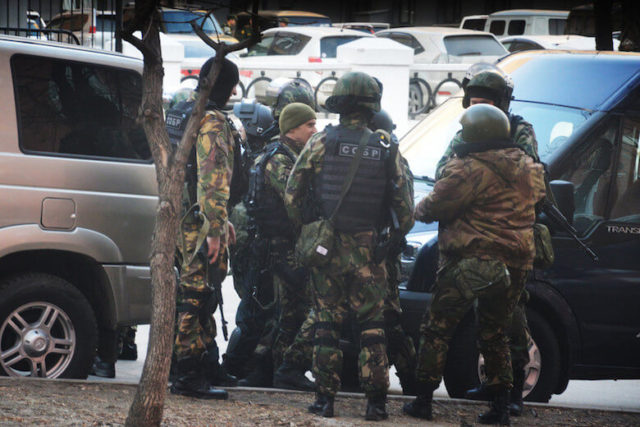
Young Gunman With Neo-Nazi Affiliation Highlights Threats to Russian State
Publication: Eurasia Daily Monitor Volume: 14 Issue: 55
By:

An underage gunman with links to Russian neo-Nazi groups burst into a Federal Security Service (FSB) building in Khabarovsk, on April 21, and opened fire. According to the FSB’s public relations center “at 17:02 (10:02 Moscow time) an unknown person entered the FSB reception room in Khabarovsk Krai and began to shoot… An employee of the FSB and one citizen of Central Asia were killed, whilst another was wounded.” The assailant was killed by FSB agents in the resulting shootout (Kommersant, April 21). Later, the FSB revealed the identity of the gunman to be A.V. Konev, a local boy born in 1999 and just 17 at the time of the shooting. Konev had procured his weapons from a local “Hammer” rifle club, after killing its instructor (Kommersant, April 21). The event brings to light the perils of loose guns in the Russian Federation, which have become increasingly disseminated throughout the country both from heists, like the one in Khabarovsk, and from the ongoing conflicts in the North Caucasus and Donbas regions (see EDM, April 11). As weapons fall into the hands of those who may actually use them, the trend raises fears of renewed terrorist violence.
The well-known opposition newspaper Novaya Gazeta reported three possible interpretations for the assailant’s motive. First, some speculate that Konov belonged to a local neo-Nazi organization called Schul’ts; for the time being, this appears to be the version that the local FSB has accepted. Indeed, screenshots purporting to show Konov’s online radicalization by neo-Nazis are circulating on the Internet. Similarly, the attack’s close proximity to Adolf Hitler’s birthday on April 20, traditionally a day of celebration for neo-Nazis (see EDM April 29, 2013), lends plausibility to this theory. Aside from this attack, however, no other significant “celebrations” of Hitler’s birthday have been reported across the Russian Federation. The second theory, put forth by the magazine Life, is that Konov was a radical Islamist who converted shortly before the attack. Apparently, investigators found links on Konov’s VKontakte page to videos of people making Molotov cocktails and shouting “Allahu Akbar.” The Islamic State also claimed responsibility for the shooting, although there are numerous incentives for them to do so even if they had no hand in the attack. The third version, proposed by the publication Meduza, is that he was a member of a group founded in Ukraine called the “Russian Insurgent Army,” which is dedicated to fighting Vladimir Putin’s regime and its associated punitive bodies (Novaya Gazeta, April 21). So far, the FSB is pursuing primarily Konov’s alleged links to neo-Nazi organizations.
This contention certainly fits with the pattern neo-Nazis have established in their relations with the Russian state. Although hate crimes have declined since the Russian illegal annexation of Crimea in 2014 and were gradually decreasing since 2009 (Sova-center.ru, accessed April 24), neo-Nazis have continued to use anti-state violence to protest a regime perceived as failing to tackle ethnic crime in Russian cities. For example, the Hot’kovo riot of 2010 saw Russians protest until the town’s authorities pledged to tackle the migrant problem. Likewise, the Birulyovo riot of 2013 drew the attention of the authorities to the problems of a working-class Moscow suburb amid claims of collusion between migrants and the authorities (Richard Arnold, Russian Nationalism and Ethnic Violence: Symbolic Violence, Lynching, Pogrom, and Massacre, Routledge, 2016). More recently, 2015 saw attempts by neo-Nazi groups to provoke pogroms in Moscow and Minneral’nye Vody; in the case of Moscow, the claims highlighted supposed collusion between the FSB and minorities from the Caucasus (Sova-center.ru, February 20, 2016). Russian far-right groups have also murdered judges, campaigned for the release of “political prisoners” (i.e. racists imprisoned for hate crimes), and declared the state to be their target in the past. The events of 2014 caused a schism in the Russian neo-Nazi movement (Robert Horvath, “The Euromaidan and the Crisis of Russian Nationalism” Nationalities Papers, 43: 6: 2015, pp. 819–839), and some went to fight with Ukrainian far-right volunteer units against Russian forces in the hopes of provoking a racial revolution inside Russia itself. As neo-Nazis return from the Ukrainian conflict with combat experience, it is likely that they will turn their attention to undermining the state’s monopoly on violence.
Indeed, this must be one of the concerns of the government given data indicating that Russian millennials are a more racist and extremist generation than those which came before. A study of youth attitudes throughout Europe (including Russia), funded by the European Union and organized through the University of Manchester, found that Russian youth were among the most receptive to radical-right ideas. Nearly 70 percent of young Russian respondents agreed that there should be restrictions on foreigners owning land and that the government should have stricter border and immigration controls (Myplaceresearch.files.wordpress.com, March 4, 2015). Against this background, the extreme youth of the assailant in Khabarovsk should give pause to officials concerned about the ease with which radical views translate into radical actions. It also provides some additional context with which to understand the significance of Alexei Navalny’s recent rally on March 26, most of whose participants were young (see EDM, March 27). Perhaps the most certain prediction is that the mixture of a closed political system, a radical youth generation, and the ready availability of weapons is a highly combustible mixture.



